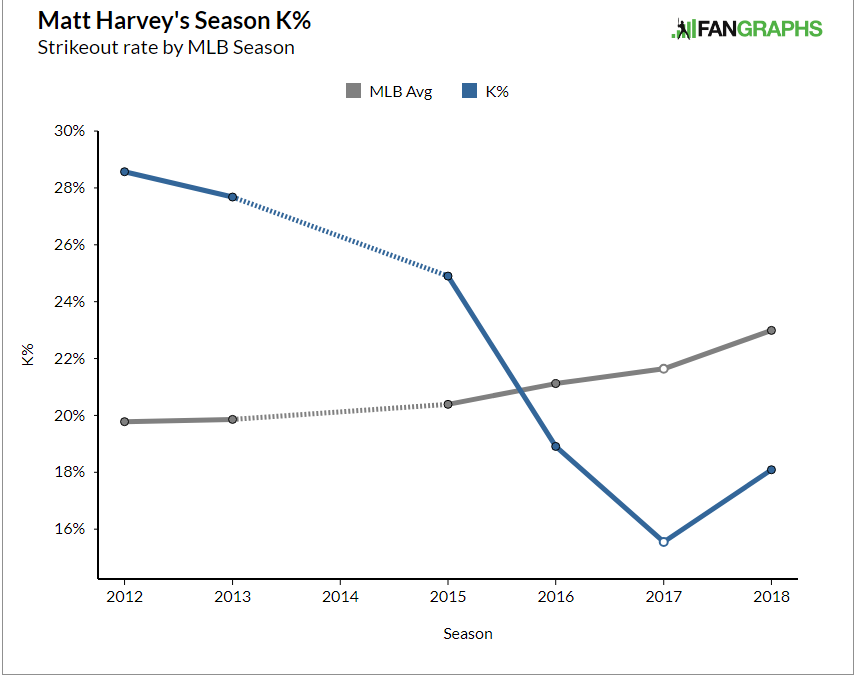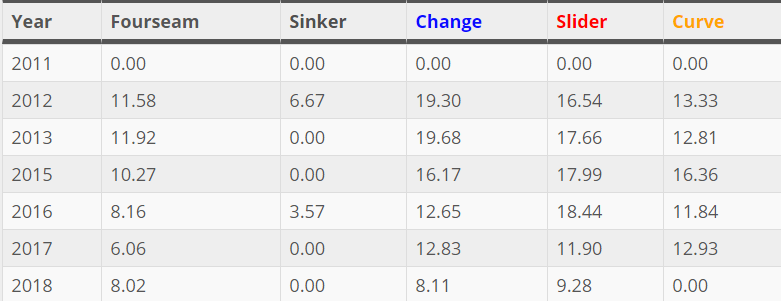It's time for the Mets to move on from Matt Harvey
As Matt Harvey walked off the mound in the bottom of the sixth inning of Thursday's game in Atlanta, he appeared confident. After all, the right-hander had retired the side in order with just 16 pitches, and he'd lasted six innings for the first time since last May, blanking the Braves over the final three.
All of that sounds great, except that Harvey had already been shelled for six earned runs across the first three innings in an eventual 12-4 loss.
Following the latest shaky performance - Harvey now sports a 6.00 ERA and 1.43 WHIP after four appearances - New York Mets manager Mickey Callaway wouldn't commit to another start for the 29-year-old, suggesting a potential demotion to the bullpen. For his part, Harvey was defiant.
"I'm a starting pitcher," he said.
The former star may think so, but in reality, it's time for the Mets to move on.
Harvey's regression has been evident since mid-2016. Injuries have certainly played a significant role, beginning in June of that year when he landed on the disabled list with thoracic outlet syndrome, leading to season-ending surgery. The rare condition, caused by compression of blood vessels and nerves that extend from the neck to the shoulder, has resulted in several other quality starters failing to regain their form over the years. In fact, thoracic outlet syndrome "possesses the potential to be career-ending (or worse)," according to Baseball Prospectus. In short, many of Harvey's struggles from 2016-18, which are evidenced in the chart below, can be attributed to the ailment.
| Year | WHIP | +WPA | RA9-WAR | BA |
|---|---|---|---|---|
| 2016-18 | 1.57 | 14.7 | -1.5 | .293 |
Among starters with at least 150 innings, Harvey has been one of the least productive pitchers in the majors. His 1.57 WHIP and .293 opponents' batting average both rank sixth worst in baseball over that span, while his minus-1.5 RA9-WAR (which calculates WAR using runs allowed) is the worst.
Gone are Harvey's glory days of 2013 - along with his triumphant return from Tommy John surgery in 2015 - when his velocity was higher and he pitched like one of baseball's best young starters:
| Year | Average fastball velo | Average release speed | K% |
|---|---|---|---|
| 2012-15 | 97 mph | 96 mph | 27 |
Combined with Jacob deGrom and Noah Syndergaard, it was no fluke that Harvey helped guide the 2015 Mets to three wins shy of a World Series title.
Since then, however, it's been an entirely different story:
| Year | Fastball velo | Release speed | K% |
|---|---|---|---|
| 2016 | 95 mph | 95 mph | 19 |
| 2017 | 94 mph | 94 mph | 16 |
| 2018 | 93 mph | 93 mph | 18 |

When a starter enters the league relying primarily on a devastating fastball to strike batters out, it becomes difficult when injuries or mechanics force them to make adjustments. This can lead to poor results, often fueled by fewer swings and misses.

As seen courtesy of Brooks Baseball in terms of opponents' isolated power, Harvey has been getting absolutely crushed when he's within parts of the strike zone. For context on ISO, anything above .150 is below average for a pitcher, while above .200 is very troubling. To make matters increasingly precarious, Harvey has generated a mere 8.3 percent of swinging strikes from 2016 through 2018, which is a 4 percent decrease from 2012-15 (12.3 percent).
The difference is substantial. Harvey was significantly better at limiting damage early on in his career, and much of that success could be attributed to his fastball, which was one of the most valuable pitches in baseball. It's been among the worst ever since.
Meanwhile, Harvey's slider and changeup - his most relied-upon secondary pitches - have also become less effective. When he broke into the league, those two pitches combined to make up 36 percent of his whiff percentage in each of his first three seasons. Though his slider was still legitimate in 2016, Harvey has mostly failed to generate swings and misses with his offspeed pitches since, which, outside of the fewer games he's played, explains his drop in strikeouts (9.5 K/9 compared to 7.0 K/9).

While cutting ties with Harvey might seem rash, consider this. The Mets flirted with the idea of trading him this winter, so while his performance has left much to be desired, they might be able to find a taker. If not, he's a free agent after this season anyway, and the Mets can simply release him, especially if he refuses a demotion to the bullpen.
Plus, with Syndergaard back in the mix and deGrom pitching better than ever, the 13-5 Mets appear more than capable of winning without Harvey's contributions. While it's certainly risky to assume Steven Matz and Zach Wheeler will pitch a full season, the club also invested in Jason Vargas this past winter, and has Seth Lugo and Robert Gsellman as depth options.
Despite resembling the hero New York deserved early in his career, Harvey has failed to pitch like his former self, so the Mets might as well look toward a future without him.